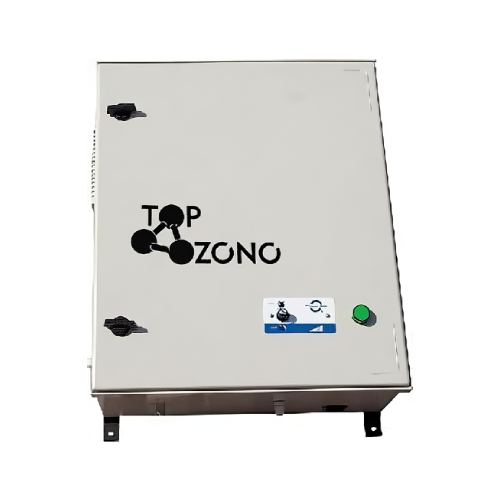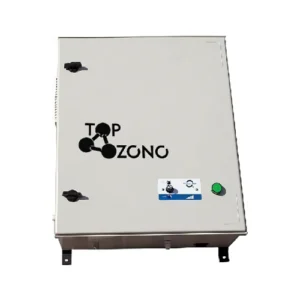7.990,00 €
Unit Multiagro 4000 mg with Nanotechnology improvement of mixture, for deposits from 500 to 1000 Litres
- Description
- Additional information
Description
Ozone treatments for irrigation agro-ecological
Ozone generation for irrigation agro-ecological
From decades ago, with an oxidation potential of 2.42 V, is recognized to Ozone (O3) as the disinfectant more powerful after fluorine (a gas is very poisonous to the human being, with a value oxidant 3.06 V), and free radical Hydroxyl HO0, with a value oxidant of 2.8 V, but unlike these, the Ozone, in controlled amounts, it is beneficial to the human being, plants and animals, and does not generate any waste, pollutant, but its residue is the simple molecule of oxygen (O2). Despite this, it has not been until recently that the Ozone Generators have been tech to offer real impact on results.
The action Deodorant and Disinfectant, Ozone (Viricida, Bactericidal, Fungicidal, Sporicidal and Protozoicida) is applied to purify and sterilize the contaminated air, among other reasons, by the effects of the concentration of living organisms in closed spaces. Your application can be carried out both in air and in water and in oil.

Use of ozonated water for irrigation," Invigorating plants "
WHAT YOU GET
- Plants and roots with more force.
- Produces thicker stems, increasing defense mechanisms in crops, especially increases in the production of resins that distance insects.
- Increase of the surface area of the roots and the leaves.
- More anchor from the roots to the ground.
- Higher rate of recovery of damaged plants.
- To protect them from infections, reduces the mortality of the plants.
- Increased resistance to pests.
- Development much faster.
- Ozone, which makes exploiting the molecules of the cell walls, achieved that microorganisms do not develop tolerance.
TO OBTAIN
- More blooms.
- Fruits symmetrical, without deformations.
- More production per plant.
- Fruits of larger size and weight.
- Fruits with more flavor and more juicy.
- More vivid colours.
- Reducing the time of production.
- To vary the biology of the soil, they took advantage of the organic components.
BENEFITS
- More harvest.
- Less time for each crop.
- Less water consumption.
- The Ozone keeps the drippers, clean and sanitary, thus avoiding clogging by contamination or deposits of biofilm acids and humic, fulvic and tannic)
- Neutralizes cyanide, ammonia, nitrite, and urea.
- Reduction and removal of plant protection products, increasing the quality of the plants and the fruits. Ideal for conversion to Organic Farming.
- Fruits of uniform, compact, strong, bigger and vivid colors.
- Thanks to a more rich in sugars, are obtained fruits with more odor and more flavorful.
- Increased shelf life of the fruits in normal environmental conditions, without adding chemicals.

Germicidal effect or microbicide ozone
By microbe means any form of life that can not be seen by the human eye, but by the use of the microscope. These living beings remain on all types of surfaces, or float in the air associated with particles of dust or water droplets in suspension, being the cause of all kinds of contagious diseases, especially in enclosed places. These micro-organisms, due to its ability to cause infectious diseases are called pathogens.
Ozone is the only antiseptic full (viruses, bacteria, prions, fungi, yeasts, spores, protozoa,...), which easily destroyed the transmission of pathogens such as E. coli and Salmonella from the environment, preventing the onset of molds and other fungi.
Microorganisms cannot develop an immunity to the ozone, since it oxidizes the membrane of cellular protein, that is to say that oxidizes its cell wall, by cracking and attacking directly, the constituents of nucleic acids (DNA and RNA).
Bactericidal effect of ozone
One of the most important advantages of Ozone with respect to other bactericides is that its effect is evidenced at low concentrations (0.01 to p. m. or less). Even with periods of very short exposure, a bacteriostatic effect and is perfectly observable.
The difference between a bactericidal effect and a bacteriostatic effect is that a bactericidal agent is capable of killing bacteria and however, a bacteriostatic agent does not get to kill them, but if it prevents them from playing, slowing down rapidly the growth of their populations.
Although theoretically be very different effects, in practice, a population of bacteria without reproductive capacity of a population is doomed to disappear. In fact, antimicrobial agents as important as some antibiotics based their power on a bacteriostatic action.

Effect viricida ozone
The virus, now regarded as the border between living beings and inert matter, are not able to live or reproduce if it is not parasitizing cells that finally destroyed. Unlike bacteria, remain a mystery, and it is believed that they are always harmful, causing diseases as common as the flu, the common cold, measles, smallpox, chickenpox, rubella, polio, hepatitis, etc
Ozone acts on the virus to go on its envelope proteins, and thus modifying its three-dimensional structure. When this occurs, the virus can't join any host cell, resulting in inhibited. Without recognizing its anchor point and to be checked out, it cannot reproduce and dies.

Fungicidal effect of ozone
There are certain types of fungi that have the ability to cause diseases. Many others are able to cause alterations in our foods, making them unacceptable for consumption, as is the case of the mold.
With ozonation, we will remove these forms pathogenic whose spores are in all kinds of environments, in order to avoid possible cell damage.

Effect of iodine in ozone
There are some fungi and bacteria that, when the conditions are adverse to its development, produce a thick wrap around them and paralyze their metabolic activity, remaining in a state of latency. When the conditions for their survival become favorable, their metabolism to recover the activity.
These forms of resistance are known as spores and are typical of bacteria as pathogens such as those that cause tetanus, gangrene, botulism or anthrax.
This type of resistance mechanism makes it very difficult to fight against them and treatments useful in other cases as high temperatures and a multitude of antimicrobials, they are ineffective in these cases. With ozonation, these micro-organisms are removed radically.

Effect protozoicida ozone
Some of the microorganisms, such as Giardia lamblia, or the more infamous Cryptosporidium, causing the majority of the diarrhea acquired in that day you will visit a swimming pool, live in almost all waters that do not have treatment by Ozone. She has even come to infect thousands of water users of the public network of large urban centres. We can consider Ozone as the only disinfectant that is valid for your removal.

Effect priocida ozone
A prion is an infective particle formed by a protein called a prion, which causes degenerative neurological diseases (ncds) such as scrapie, Creutzfeldt-Jakob disease and bovine spongiform encephalopathy.
The ozonation eliminate this form of contagion in all kinds of environments, in order to avoid possible cell damage.

The contamination of soils
For agriculture, we can consider that the soil acts as a reservoir of mineral nutrients required by plants.
The plants absorb essential minerals by means of inorganic ions dissolved in the water. When these mineral nutrients stored in the soil dissolve in water, plant roots, through their root hairs, are able to absorb them to transport the mineral across the cortex of the root to reach the endodermis, from where it is distributed to the rest of the plant.
There are 13 elements considered as major minerals by their effects on the plants and these are: Nitrogen, Potassium, Phosphorus, Calcium, Magnesium, Sulfur, Iron, Manganese, Zinc, Boron, Copper, Silicon, and Molybdenum, and are part of the nutrient solution used in hydroponic growing. To maintain the balance between nutrients will be essential to achieve the best performance in the agricultural operation.
Soils can be contaminated and low productivity for several reasons:
- Microorganisms that cause disease to plants. The organisms are anaerobic (living without oxygen) are responsible for rot and contaminate crops. Repeated cultivation reaches a load of these pathogens soils, agotándolos crop after crop. The excess of irrigation, the use of regenerated water and flooding proliferate all kinds of fungi and anaerobic microorganisms that reduce the ability of the soil for agricultural applications. To lower rate of oxygen in the soil, the greater number of microorganisms that cause root rot in crops.
- By using groundwater, which degraded the quality of these soils. The ions build up causing the alkalinity or elevation of the element sodium, boron, etc. contamination, fecal and E. coli can also cause serious problems, especially in consumer products in the raw, like lettuce.

The irrigation with Ozone in agriculture
The plants are composed of 80% water, constituting, therefore, its main component. Being the main contribution of nutrients to the plant, the water used for irrigation should not be underestimated, because the final production will depend on the quality of that water.

The ozonation in the irrigation for years, both in intensive crops, or greenhouse, as in extensive, or open field, comes benefiting the entire class of plantations of vegetables, fruit trees, olive groves, vineyards, etc, The ozonated water is used in all types of crops, both conventional and organicapplied to irrigation by sprinkler, micro-sprinkler, drip, surface irrigation, or by gravity, water, and misting. Using Ozone, can be grown in a completely organic, without prejudice to the profitability of the exploitation, but on the contrary, making it increase.
In conventional agriculture, organic compounds in the soil are converted into mineral nutrients by physical-chemical processes and, more slowly, by biological processes through the humus. Ozone accelerates the mineralization without the need of use of other agents, by converting the organic matter in a soil rich in nutrients for the plants. Ozone increases and preserves the fertility of the soil medium and long term.
The high quality of the water obtained with ozonation facilitate the dilute better the soluble nutrients that are then absorbed by the roots, thus allowing to reduce the water consumption, saving on your use.
It is important to note that the greater the use of manure, liquid manure or lisier as a fertilizer, the greater is the risk of biological contamination by organisms such as Escherichia coli O157:H7. To effectively remove E. coli and other pathogens in the water content, the ozonation limits that risk. In order to disinfect, you can also ozonizarse the slurry, much more effective than aerate them.
Diseases caused by fungi, such as, for example, Rhizoctonia, Fusarium, Phytophthora, Pythium, disease of the Kindling of the vine, etc, are eradicated with the ozonation. It is known the power of Trichodermas in the degradation of several groups of pesticides of high-strength, among which are also organochlorines. Although both will remain with the ozonation we rely entirely on the Mycorrhizal and the Trichodermas, a group of fungi that are found in soils that are balanced and which play an important collaborative role and plant defense, especially against nematodes. Also we can come to dispense with the fungus Beauveria Bassiana (formerly called Botrytis bassiana), used as a biological insecticide.
How do you achieve that?
The water treated with Ozone leads to the roots through irrigation.
- Balances colonies, eliminating microorganisms: removes fungi, viruses, bacteria and other microorganisms that hinder the absorption of nutrients, and tend to limit their growth.
- Control insect: its bacteriostatic effect prevents insects from reproducing and spreading plague, being sensitive to Ozone, cysts, eggs and larvae.
- Oxygenates the floor: with the water, the substrate will be losing oxygen. Using ozonated water, the roots will absorb the water with greater rates of Oxygen, something that will energize your entire structure, will help to take root and develop faster.

The handling of hazardous chemicals by farmers, causes or chronic exposure to high concentrations of certain pesticides and can cause damage to the nervous system, kidneys, liver, and brain, not something that happens by working with the ozonation.
The irrigation with Ozone repairs degraded soils and contaminated pathogens, by ransoming them and preparing them for new seasons. The Ozone brings an end to pest problems and recurrent already out of control.
The Ozone in the preparation of the soil
It is known that a good preparation of the ground, helping to increase agricultural production by up to 30%, reaching and overcoming those yields more easily when you use ozonated water. Among the benefits obtained by the Ozone in the preparation of the soil can be highlighted:
- Improves the flow of the water and the air, preventing it from forming on the ground hard layers that limit the penetration and growth of the roots, and improving the erosion resistance.
- By incorporating as a fertilizer dissolved organic matter, increases the availability of nutrients, improving soil fertility.
- All this will help to optimize the regimes of temperature and soil moisture.
- Prevents the formation of the sealing surface of the soil.

Technical Characteristics
| Model | For Deposits of Water | Production O3/h | |
| U. MULTIAGRO-4G | From 500 To 1000 Liters | 4000 mg |
Additional information
| Weight | 70 kg |
|---|---|
| Dimensions | 100 × 70 × 50 cm |




